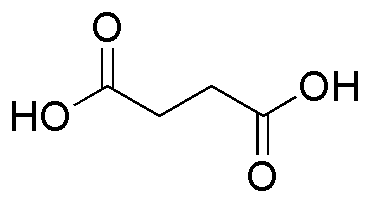Succinic acid is widely utilized in research focused on:
- Food Industry: It serves as a flavoring agent and preservative, enhancing the taste of various food products while extending shelf life.
- Pharmaceuticals: Used in the synthesis of active pharmaceutical ingredients, it plays a crucial role in drug formulation and development.
- Biotechnology: As a building block for biopolymers, it is essential in producing biodegradable plastics, contributing to sustainable practices in manufacturing.
- Agriculture: It acts as a soil conditioner, improving nutrient availability and promoting plant growth, which is vital for enhancing crop yields.
- Cosmetics: Incorporated in skincare products, it helps in moisturizing and maintaining skin elasticity, making it a popular ingredient in beauty formulations.
General Information
Properties
Safety and Regulations
Applications
Succinic acid is widely utilized in research focused on:
- Food Industry: It serves as a flavoring agent and preservative, enhancing the taste of various food products while extending shelf life.
- Pharmaceuticals: Used in the synthesis of active pharmaceutical ingredients, it plays a crucial role in drug formulation and development.
- Biotechnology: As a building block for biopolymers, it is essential in producing biodegradable plastics, contributing to sustainable practices in manufacturing.
- Agriculture: It acts as a soil conditioner, improving nutrient availability and promoting plant growth, which is vital for enhancing crop yields.
- Cosmetics: Incorporated in skincare products, it helps in moisturizing and maintaining skin elasticity, making it a popular ingredient in beauty formulations.
Documents
Safety Data Sheets (SDS)
The SDS provides comprehensive safety information on handling, storage, and disposal of the product.
Product Specification (PS)
The PS provides a comprehensive breakdown of the product’s properties, including chemical composition, physical state, purity, and storage requirements. It also details acceptable quality ranges and the product's intended applications.
Certificates of Analysis (COA)
Search for Certificates of Analysis (COA) by entering the products Lot Number. Lot and Batch Numbers can be found on a product’s label following the words ‘Lot’ or ‘Batch’.
*Catalog Number
*Lot Number
Certificates Of Origin (COO)
This COO confirms the country where the product was manufactured, and also details the materials and components used in it and whether it is derived from natural, synthetic, or other specific sources. This certificate may be required for customs, trade, and regulatory compliance.
*Catalog Number
*Lot Number
Safety Data Sheets (SDS)
The SDS provides comprehensive safety information on handling, storage, and disposal of the product.
DownloadProduct Specification (PS)
The PS provides a comprehensive breakdown of the product’s properties, including chemical composition, physical state, purity, and storage requirements. It also details acceptable quality ranges and the product's intended applications.
DownloadCertificates of Analysis (COA)
Search for Certificates of Analysis (COA) by entering the products Lot Number. Lot and Batch Numbers can be found on a product’s label following the words ‘Lot’ or ‘Batch’.
*Catalog Number
*Lot Number
Certificates Of Origin (COO)
This COO confirms the country where the product was manufactured, and also details the materials and components used in it and whether it is derived from natural, synthetic, or other specific sources. This certificate may be required for customs, trade, and regulatory compliance.


